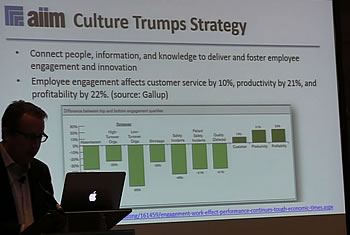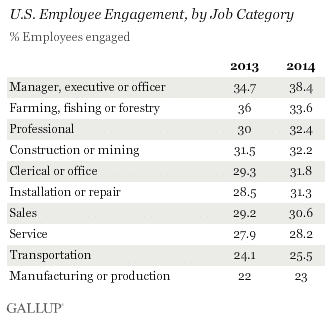
If management isn’t focused enough on the key role of customer service and doesn’t take into account the input of frontline staff, the bottom line is at risk.
In a nutshell it’s what my previous blog post covered. The link between customer service, management and staff is also one of customer engagement and employee engagement.
Employee engagement is known to positively impact customer service, productivity and profitability – among others. And it’s simply common sense: you need people to do business, work and serve customers and they like to be valued and respected just as much as they do in any other capacity.
At the AIIM Forum UK 2015 Atle Sjekkeland tackled the key role of engagement in a context of information management and digital transformation. When looking at where the budgets in digital transformation efforts are going, Atle stated that the first of four investment priorities indeed concerns improving engagement.
Improving customer engagement is about more than the customer
Within that ‘engagement’ category most is spent on customer engagement. That’s not really a surprise but important to remind. After all, if we spend a lot to improve customer engagement, service, customer experience, our contact centers and everything else that aims to better engage with and serve customers, a holistic focus on customer service and engagement is needed.
We better spend well, looking at the overall picture. If not we simply throw money away, for instance if we don’t connect the company’s strategy, customer-facing operations and back-office processes. Among the many reasons why budgets primarily go to customer engagement is a reality many industries are faced with: disruptive challengers outperforming with a genuine focus on customer service using all the tools today’s customers simply want.
Employee engagement and customer engagement: the correlation
However, you can’t improve customer engagement without improving employee engagement, Atle continued. In other words: investing in engagement, service and customer experience optimization also means looking at the improvement of employee engagement. CX practitioners know it, as do many others. However, some seem to forget it far too often. Atle referred to Gallup’s well-known study, indicating that employee engagement affects customer service by 10%, productivity by 21% and profitability by 22%.
The correlation between employee engagement and customer engagement de facto is probably even higher. After all, business is still human and people – your staff and knowledge workers – make the difference across all interactions customers have with the business, making up that big end-to-end customer experience.
One of the key human needs is to be heard, understood and taken into account. The same is true in our work.
If, as indicated in the previous post, frontline staff that cares about customer service, feels its’ input is not heard or taken seriously, you don’t only risk losing customers. You also risk losing your most caring staff.
Customer-facing workers with the right mind set often are really embarrassed when they don’t have the information and underlying processes to serve customers in daily operations and interactions. The shame they feel because they know what the issues are but can’t tell the customer as you don’t want that is destructive for their perception towards the company they work for. Customers feel that: they feel the difference between engaged and motivated staff on one hand and workers who are happy to do their jobs on the other. Or better: customers feel the enthusiasm of the highly motivated and engaged employee.

Employee engagement is a big topic. And since several years it gets more attention from customer experience and service professionals who know and see the correlation between employee engagement, customer engagement and all those things you don’t want to happen: your best staff leaving, increasing churn, customers complaining publicly, disruptive companies massively winning the hearts of consumers, etc. Knowing that employee engagement in service is already among the lowest according to Gallup, the challenge is clear.
Employee engagement considerations
Before talking more about the link between customer engagement, employee engagement and the crucial role of information management and processes in it all, here are a few considerations:
A people-oriented culture includes staff
Just as is the case with customer service and the customer experience, the basics matter. Culture, listening, taking people into account, connecting the dots, practicing what you preach instead of paying lip service to it. In practice these basics are often hard to realize, especially when they require change – and they do. Actionable leadership is key in it.
Create feedback loops and get closer
Look at the overall picture of employee engagement. Again: people want to be heard and valued. It’s important to create feedback loops, involving your frontline staff. The days that top management is shielded from the reality on the work floor and the input from workers by an army of executives who ‘filter’ the information the C-level suite hears should be over.
Mind new ways and preferences of working
But it’s also important to understand the changing needs of staff and their desire to work in new ways, more flexible ways. Especially with new generations coming in, that’s a crucial issue. To quote Atle who mentioned other research by Cisco, 45% of young professionals would accept a lower paying job with more flexibility rather than a higher-paying job with less. But that’s for a next blog post. In the meantime here’s another finding, from Gallup’s latest employee engagement report: younger workers are least engaged.

